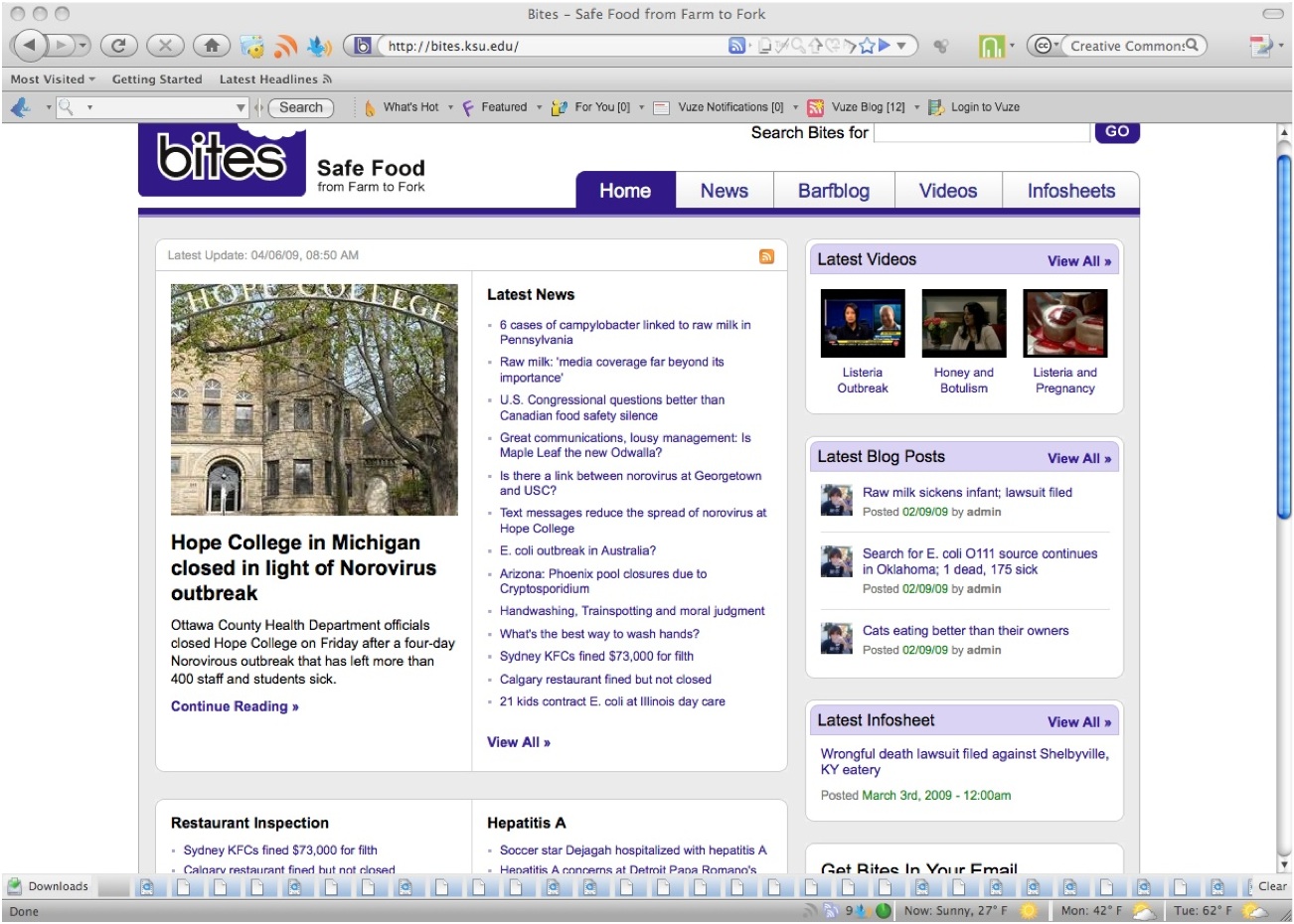Foodborne illness can be an unpleasant experience or something more serious. The World Health Organization estimates up to 2 billion people get sick from food and water each year – 30 per cent of all citizens in all countries.
 Dr. Douglas Powell, associate professor of food safety at Kansas State University, leads a group of individuals passionately committed to reducing the incidence of foodborne illness, through research, teaching and information. The group strives daily to be the international leader in comprehensive and compelling food safety information that impacts individual lives – and reduces the number of sick people.
Dr. Douglas Powell, associate professor of food safety at Kansas State University, leads a group of individuals passionately committed to reducing the incidence of foodborne illness, through research, teaching and information. The group strives daily to be the international leader in comprehensive and compelling food safety information that impacts individual lives – and reduces the number of sick people.
The electronic publications, barfblog.com and bites.ksu.edu, are comprehensive, current and compelling sources of food safety news and analysis, and help foster a farm-to-fork culture that values microbiologically safe food.
Research
• The effectiveness of food safety messages and media in public discussions of food safety issues, such as the risks of listeria to pregnant women, legislation surrounding raw milk, public availability of restaurant inspection data, and the safety of fresh produce, are evaluated through qualitative and quantitative methods.
• Observational research methodologies are used to quantify individual food safety behaviors from farm-to-fork, to enhance handwashing compliance, thermometer use, food packaging information and interventions that can reduce the number of people that get sick from the food and water they consume.
 Teaching
Teaching
• A graduate program in food safety risk analysis – including food safety, language, culture and policy — is being developed and will include distance-education.
• Courses are currently taught in Food Safety Risk Analysis, and Food Safety Reporting.
Information
• Dr. Powell is the publisher and editor of bites and barfblog, rapid, reliable and relevant sources of food safety information. Dr. Ben Chapman of North Carolina State University is the assistant editor.
• bites and barfblog are produced by a cross-cultural team of secondary, undergraduate and graduate students as well as professionals who create multilingual and multicultural food safety and security information, including weekly food safety information sheets, and multimedia resources.
• Research, educational and journalistic opportunities are available for secondary, undergraduate and graduate students through bites.ksu.edu and barfblog.com.
For further information, please contact:
Dr. Douglas Powell
associate professor, food safety
dept. diagnostic medicine/pathobiology
Kansas State University
Manhattan, KS
66506
cell: 785-317-0560
fax: 785-532-4039
dpowell@ksu.edu
bites.ksu.edu
barfblog.com
donteatpoop.com
youtube.com/SafeFoodCafe
or
Dr. Benjamin Chapman
Food Safety Specialist
Department of 4-H Youth Development and Family & Consumer Sciences
NC Cooperative Extension Service
North Carolina State University
Campus Box 7606 (512 Brickhaven Drive)
Raleigh, NC 27695-7606
919.515.8099 (office)
919.809.3205 (cell)
benjamin_chapman@ncsu.edu

.jpg)
.jpg) The four listservs – FSnet, Agnet, Animalnet and FFnet – are going to be
The four listservs – FSnet, Agnet, Animalnet and FFnet – are going to be 

 That’s why they use pictures like the one, right, to portray the organic industry. I look at the picture and wonder where those hands have been and what kind of poop is being spread on that fresh produce.
That’s why they use pictures like the one, right, to portray the organic industry. I look at the picture and wonder where those hands have been and what kind of poop is being spread on that fresh produce. Those were the waning days of higher education. The student newspaper had just completed its annual homegrown judging contest, and students could purchase beer with their meal cards. There was also a thriving entrepreneurial culture of meal card scalping. Because new cards were issued at the beginning of each semester, the value would decline as the semester wore on. In the last few weeks, $20 meal cards could be had for $12, which could then be transformed into several pitchers of beer.
Those were the waning days of higher education. The student newspaper had just completed its annual homegrown judging contest, and students could purchase beer with their meal cards. There was also a thriving entrepreneurial culture of meal card scalping. Because new cards were issued at the beginning of each semester, the value would decline as the semester wore on. In the last few weeks, $20 meal cards could be had for $12, which could then be transformed into several pitchers of beer. 

 Amy will be cheering for the underdog Baltimore Ravens, because back-up wide receiver and special teams specialist
Amy will be cheering for the underdog Baltimore Ravens, because back-up wide receiver and special teams specialist  One such blog is Powell’s barfblog.com, a site that receives more than 5,000 visitors daily. The site operates with the understanding that to compel audiences to change their food-handling behaviors, the messages should be rapid, reliable, relevant and repeated, Powell said. The blog is available at
One such blog is Powell’s barfblog.com, a site that receives more than 5,000 visitors daily. The site operates with the understanding that to compel audiences to change their food-handling behaviors, the messages should be rapid, reliable, relevant and repeated, Powell said. The blog is available at  In one particular episode, Barney and Fred join Joe Rockhead’s volunteer fire department as a cover for the dance lessons they are taking so they do not humiliate themselves at the charity ball.
In one particular episode, Barney and Fred join Joe Rockhead’s volunteer fire department as a cover for the dance lessons they are taking so they do not humiliate themselves at the charity ball.